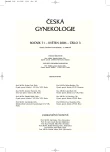-
Medical journals
- Career
Effect of Early Onset of Transdermal and Oral Estrogen Therapy on the Lipid Profile: a Prospective Study with Cross-over Design
Authors: Tomáš Fait 1; M. Vráblík 2; Z. Žižka 1; B. Trnková 3; J. Mašata 1; J. Živný 1
Authors‘ workplace: Gynekologicko-porodnická klinika 1. LF UK a VFN, Praha, prof. MUDr. A. Martan, DrSc. 1; III. interní klinika 1. LF UK a VFN, Praha, prof. MUDr. Š. Svačina, DrSc. MBA. 2; Ústav klinické biochemie a laboratorní diagnostiky 1. LF UK a VFN, Praha, prof. MUDr. T. Zima, DrSc. MBA. 3
Published in: Ceska Gynekol 2006; 71(3): 226-230
Category: Original Article
Overview
Objective:
The aim of study was to evaluate changes of lipid profil during different types of estrogen replacement therapy (ERT).Design:
Prospective randomized study.Setting:
1st Faculty of Medicine and General Faculty Hospital Prague.Methods:
Two routes of administration were used for 12 weeks: oral estradiol 2 mg/day and transdermal estradiol 50 μg/day (7-day pathes). Forty five healthy women with average age 49 ± 6 years were randomised into prospective cross-over designed study. Forty one women finished the study and were analysed. Blood collections were performed from veins on the beginning of study and during last week of each therapeutic interventions. Statistical results have counted by paired t-test.Results:
Total cholesterol levels were not changed. Triglycerides grew up from 1,39 ± 0,9 mmol/l to 1.61 ± 0.8 mmol/l (p = 0,004) after oral ERT. This results showed significant (p = 0.0001) differences between oral and transdermal application because of nonsignificant (p = 0.187) lowering trends after transdermal ERT. The elevation of HDL levels after oral ERT (from 1.85 ± 0.39 mmol/l to 2.09 ± 0.42 mmol/l, p = 0.0001) was significantly (p = 0.009) more favourable than after transdermal ERT (to 1.96 ± 0.42 mmol/l, p = 0.029). Changes of LDL levels are also more favourable (p = 0.0001). LDL levels decreased after oral ET from 3.06 ± 0.97 mmol/l to 2.52 ± 0.71 mmol/l in comparison with the nonsignificant decline on 3.0 ± 1.0 mmol/l after transdemal ERT.Conclusion:
All data from lipid metabolism had more favourable changes after oral ET with the exception of triglycerides. Knowledge of the patient’s lipid profile and it’s changes after each type of estrogen applications enable doctors individualisation of hormone replacement therapy from this point of view.Key words:
hormone replacement therapy, cardiovascular diseases, lipoproteins, cholesterol
Labels
Paediatric gynaecology Gynaecology and obstetrics Reproduction medicine
Article was published inCzech Gynaecology

2006 Issue 3-
All articles in this issue
- ST Analysis of Fetal ECG in Premature Deliveries during 30th–36th Week of Pregnancy
- Discrepancy of Ultrasound Biometric Parameters of the Head (HC - Head Circumference, BPD - Biparietal Diameter) and Femur Length in Relation to Sex of the Fetus and Duration of Pregnancy
- Prevention of Rh (D) Alloimmunization in Rh (D) Negative Women in Pregnancy and after Birth of Rh (D) Positive Infant
- Velocimetry of the Ductus Venosus in the First Stage of Labor
- Intrahepatic Cholestasis of Pregnancy – Four Case Reports
- Prenatal Diagnostics of Birth Defects in the Czech Republic – Gestational Week at the Time of Diagnosis
- Birth Defects Occurrence in the Czech Republic in 2003
- Serum Antibodies against Annexin V and Other Phospholipids in Women with Fertility Failure
- Embryo Quality Evaluation according to the Speed of the first Cleavage after IntraCytoplasmic Sperm Injection (ICSI)
- Changes in Values of Urethral Closure Pressure and its Position after Burch Colposuspension – Predictive Value of MUCP and VLPP for Successful Rate of this Operation
- Office Hysteroscopy - State of the Art
- Effect of Early Onset of Transdermal and Oral Estrogen Therapy on the Lipid Profile: a Prospective Study with Cross-over Design
- Sentinel Lymph Node Detection Using 99mTc-nanocolloid in Endometrial Cancer
- Guideline for Gynecological Malignant Tumors I. Standard – a Complex Therapy of Ovarian Epithelial Malignant Tumors
- Hereditary Ovarian Cancer
- Prognostic Factors of Ovarian Cancer
- Czech Gynaecology
- Journal archive
- Current issue
- Online only
- About the journal
Most read in this issue- Discrepancy of Ultrasound Biometric Parameters of the Head (HC - Head Circumference, BPD - Biparietal Diameter) and Femur Length in Relation to Sex of the Fetus and Duration of Pregnancy
- Serum Antibodies against Annexin V and Other Phospholipids in Women with Fertility Failure
- Intrahepatic Cholestasis of Pregnancy – Four Case Reports
- Prevention of Rh (D) Alloimmunization in Rh (D) Negative Women in Pregnancy and after Birth of Rh (D) Positive Infant
Login#ADS_BOTTOM_SCRIPTS#Forgotten passwordEnter the email address that you registered with. We will send you instructions on how to set a new password.
- Career

